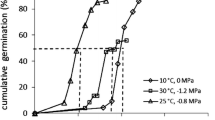Abstract
Phytotoxic studies strongly depend on evaluation of germination responses, which implies the need for adequate procedures to account for distinct aspects of the germinative process. For this, indices, comparisons among treatments at various times, and model fitting have been proposed. The objective of this work is to compare the three approaches and select the one providing the greatest insight and precision. Speed of germination, speed of accumulated germination, the coefficient of the rate of germination, comparisons at each determination time, including final germination, and the parameters of the Weibull function were examined. The Weibull function proved the best approach to describe the germination process, providing not only the same type of information about the speed of germination, with greater precision, but also additional information about the initiation and shape of the germination response curve.
Similar content being viewed by others
REFERENCES
AN, M., PRATLEY, J. E., and HAIG, T. 1996. Differential phytotoxicity of Vulpiaspecies and their plant parts. Allelopathy J.3:185-194.
BONNER, F. T., and DELL, T. R. 1976. The Weibull function: A new method of comparing seed vigor. J. Seed Technol.1:96-103.
BOUTON, J. H., DUDECK, A. E., and SMITH, R. L. 1976. Germination in freshly harvested seed of centipedegrass. Agron. J.68:991-992.
BROWN, R. F. 1987. Germination of Aristida armataunder constant and alternating temperatures and its analysis with the cumulative Weibull distribution as a model. Aust. J. Bot.35:581-591.
BROWN, R. F., and MAYER, D. G. 1988. Representing cumulative germination. 2. The use of the Weibull function and other empirically derived curves. Ann. Bot.61:127-138.
CHEW, V. 1976. Comparing treatment means: A compendium. HortScience11:348-357.
CHIAPUSIO, G., SáNCHEZ, A. M., REIGOSA, M. J., GONZáLEZ, L., and PELLISSIER, F. 1997. Do germination indices adequately reflect allelochemical effects on the germination process J. Chem. Ecol.23:2445-2453.
DIAS, L. S. 1991. Allelopathic activity of decomposing straw of wheat and oat and associated soil on some crop species. Soil Tillage Res.21:113-120.
DIAS, L. S., PEREIRA, I. P., and DIAS, A. S. 1999. Research on allelopathy in Portugal, pp. 89-98, inS. S. Narwal (ed.). Allelopathy Update. 1. International Status. Science Publishers, Inc., Enfield, New Hampshire.
EDWARDS, T. I. 1934. Relations of germinating soy beans to temperature and length of incubation time. Plant Physiol.9:1-30.
EINHELLIG, F. A., SCHON, M. K., and RASMUSSEN, J. A. 1982. Synergistic effects of four cinnamic acid compounds on grain sorghum. J. Plant Growth Regul.1:251-258.
GOODCHILD, N. A., and WALKER, M. G. 1971. A method of measuring seed germination in physiological studies. Ann. Bot.35:615-621.
HSU, F. H., NELSON, C. J., and CHOW, W. S. 1984. A mathematical model to utilize the logistic function in germination and seedling growth. J. Exp. Bot.35:1629-1640.
JANSSEN, J. G. M. 1973. A method of recording germination curves. Ann. Bot.37:705-708.
KENDRICK, R. E., and FRANKLAND, B. 1969. Photocontrol of germination in Amaranthus caudatus. Planta (Berlin)85:326-329.
KOTOWSKI, F. 1926. Temperature relations to germination of vegetable seed. Proc. Am. Soc. Hortic. Sci.23:176-181.
LEHLE, F. R., and PUTNAM, A. R. 1982. Quantification of allelopathic potential of sorghum residues by novel indexing of Richard's function fitted to cumulative cress seed germination curves. Plant Physiol.69:1212-1216.
MAGUIRE, J. D. 1962. Speed of germination-aid in selection and evaluation for seedling emergence and vigor. Crop Sci.2:176-177.
RIETVELD, W. J. 1975. Phytotoxic grass residues reduce germination and initial root growth of ponderosa pine. USDA Forest Service, RP RM-153, 15 pp.
SCHIMPF, D. J., FLINT, S. D., and PALMBLAD, I. G. 1977. Representation of germination curves with the logistic function. Ann. Bot.41:1357-1360.
THORNLEY, J. H. M. 1977. Germination of seeds and spores. Ann. Bot.41:1363-1365.
WARDLE, D. A., NICHOLSON, K. S., and RAHMAN, A. 1996. Use of a comparative approach to identify allelopathic potential and relationship between allelopathy bioassays and “competition” experiments for ten grassland and plant species. J. Chem. Ecol.22:933-948.
WEIBULL, W. 1951. A statistical distribution function of wide applicability. J. Appl. Mech.18:293-297.
Author information
Authors and Affiliations
Rights and permissions
About this article
Cite this article
Dias, L.S. Describing Phytotoxic Effects on Cumulative Germination. J Chem Ecol 27, 411–418 (2001). https://doi.org/10.1023/A:1005644808956
Issue Date:
DOI: https://doi.org/10.1023/A:1005644808956




